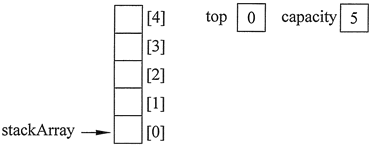順序棧及其(C++)實現
2020-07-16 10:04:43
| 成員變數 | 描 述 |
|---|---|
| stackArray | 指向整數陣列的 unique_ptr 獨佔指標。當建構函式執行時,它使用 stackArray 動態分配陣列的儲存 |
| capacity | 一個儲存棧的大小的整數。這是棧最多可以儲存的元素的個數,而不是當前棧中元素的最大值 |
| Top | 用來標記棧頂的整數。它指定將被新增到棧的下一個專案的位置 |
該類的成員函數如表 2 所示:
| 成員函數 | 描 述 |
|---|---|
| 建構函式 | 該類別建構函式將接受一個整數引數,該引數指定了棧的大小。這個大小的整數陣列被動態分配儲存並賦值給 stackArray。另外,變數 top 被初始化為 0,表示棧當前為空 |
| push | push 函數接受一個整數引數,該引數將被壓入棧頂 |
| pop | pop 函數使用一個整數參照形參。棧頂部的值被刪除並複製到參照形參中 |
| isEmpty | 如果棧為空則返回 true,否則返回 false。top 設定為 0 時則棧為空 |
注意,即使建構函式會動態地為棧陣列分配儲存,但是它仍然被視為一個順序棧,因為一旦分配完畢,該棧的大小就不能改變。
該類的程式碼顯示如下://IntStack.h 的內容
#include <memory>
using namespace std;
class IntStack
{
unique_ptr<int[]>stackArray;
int capacity;
int top;
public:
// Constructor
IntStack(int capacity);
// Member functions
void push(int value);
void pop (int &value);
bool isEmpty() const;
// Stack Exceptions
class Overflow {};
class Underflow {};
};
除了表 2 中描述的棧成員之外,IntStack 類還定義了兩個名為 Overflow 和 Underflow 的內部類,用作棧異常。如果在程式碼執行過程中,遇到了程式碼無法按既定任務執行的情況,則稱該程式碼段出現異常。在順序棧的情況下,如果棧中沒有更多的空間,則在呼叫 push 壓棧的過程中就會發生溢位異常。同樣,如果在呼叫 pop 出棧時棧內卻沒有任何內容可以返回,則會發生下溢異常。
程式碼在檢測到異常發生之後,會立即通知程式的其餘部分,方法是建立描述異常的值並使用 throw 語句將該值傳遞給程式的其餘部分。
例如,push 函數可通過執行以下語句來通知發生溢位異常:
throw InstStack::Overflow();
而 pop 函數則可以執行以下語句:throw IntStack::Underflow();
該語句通知程式發生了下溢異常。預設情況下,當程式的任何部分丟擲異常時,程式將終止並顯示錯誤訊息。這個預設行為可以通過一個被稱為捕獲異常的進程來改變。IntStack 建構函式可分配一個指定容量的陣列,並將成員變數 top 設定為 0。所有的棧函數都使用 top,使它始終指向棧陣列中的下一個可用槽。當 top 等於 capacity 時,沒有更多的槽用於儲存值,下一次 push 的呼叫就會拋出異常。
同樣,當 top 為零時,棧就是空的,對 pop 的呼叫會丟擲一個異常。因為在程式中沒有任何規定來捕捉這兩個異常,所以它們中的任何一個都會以錯誤資訊終止程式。注意,在向棧中新增一個值之後,push 會遞增 top 的值;而在返回儲存在 stackArray[top] 中的值之前,pop 會遞減 top 的值。
//IntStack.cpp 的內容
#include "intstack.h"
IntStack::IntStack(int capacity)
{
stackArray = make_unique<int[]>(capacity);
this->capacity = capacity;
top = 0;
}
void IntStack::push(int value)
{
if (top == capacity)
throw IntStack::Overflow();
stackArray[top] = value;
top++;
}
bool IntStack::isEmpty() const
{
return top == 0;
}
void IntStack::pop(int &value)
{
if (isEmpty()) throw IntStack::Underflow();
top--;
value = stackArray[top];
}
下面的程式演示了棧類及其成員函數的使用。請注意,在出棧的時候,其順序剛好和值入棧的順序相反。
// This program illustrates the IntStack class.
#include "intstack.h"
#include <iostream>
using namespace std;
int main()
{
IntStack stack(5);
int values[] = { 5, 10, 15, 20, 25 };
int value;
cout << "Pushing. . . n";
for (int k = 0; k < 5; k++)
{
cout << values[k] << " ";
stack.push(values[k]);
}
cout << "nPopping. . .n";
while (!stack.isEmpty())
{
stack.pop(value);
cout << value << " ";
}
cout << endl;
return 0;
}
程式輸出結果:
Pushing. . .
5 10 15 20 25
Popping. . .
25 20 15 10 5

圖 1 使用建構函式和引數 5 建立的棧